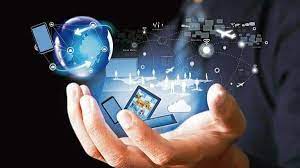When the old year ends and the new year starts, I like to do both a backward look at what happened in the tech year in the past year, as well as what trends are emerging for the upcoming year.
So I’ll ring this year in with a summary of a few articles I saw that recapped 2023.
It will be no surprise to anyone that AI is high on everyone’s 2023 list.

Source: livemint.com
TechTarget’s Kaitlin Herbert reviewed the year from the business perspective, and led things off with a look at the AI arenas that took off last year.
Generative AI holds the promise of revolutionizing various sectors, including personalized education, real-time translation, advanced assistive technologies and streamlined content creation. LLM chatbots — such as OpenAI’s ChatGPT and Google’s Bard — can increase access to knowledge, foster cross-cultural communication and empower individuals with disabilities.
Herbert raises some cautions, however, regarding built in biases (so far, anyway), the potential for misuse, and a lack of understanding (so far, anyway), that sometimes produces answers and content that are ludicrously wrong. But it’s getting better and better all the time, and, for all our fears that generative AI will end up replacing humans in many high-skilled occupations, it will also lead to new jobs for prompt engineers, content creators, communications professionals, and educators.
The other “big stories” in the tech business that she noted include the collapse of the Silicon Valley Bank, which impacted many early stage companies; the FTX scam that centered on founder Sam Bankman-Fried, but also involved a number of celebrities who got swept away with their enthusiasm for cryptocurrency (which generally came with a paid gig to endorse it); and the often soap-opera level ups and downs at Twitter/X.
ZDNet’s June Wan focused on 2023’s major tech game-changers. Again, first up was AI, specifically on-device AI, which Wan sees as a big win across the boards.
Running AI applications locally yields four major advantages: 1) All information, including personal, financial, and medical, are stored and processed within the device, not externally, 2) Location data and user preferences and activity can be leveraged to create more personal AI assistants, 3) There will be a noticeable drop in latency and processing times, and 4) The omission of cloud computing significantly reduces the energy consumption of data centers, a betterment for environmental sustainability.
Generative AI for professional workflows was Wan’s next big win, with shout-outs to Canva, Apple, and Adobe for the AI tools they’ve implemented.
Then there’s Microsoft Co-Pilot, the AI assistant for Windows 11 apps, which got more than a little shout out.
At the base level, Copilot on Windows 11 can save users dozens of clicks every day, now that the AI assistant can help navigate those sophisticated location paths to tweak display resolutions, set dark theme timers, and do other mundane tasks. For businesses and enterprises, Copilot will be capable of tackling cybersecurity threats, from risk identification with machine learning algorithms to automated response mechanisms for near-instant defense.
The results of all this?
Such workloads, especially as companies fine-tune these large language models, often require pushing the GPUs (graphics processing units) and RAM in computers and servers to the max, setting a precedent for an AI arms race between the world’s largest semiconductor companies — Intel, AMD, Nvidia, and Qualcomm included. Expect more “for AI” computers, chipsets, and fancy comparison charts in 2024.
The other breakthroughs that Wan noted were wireless TV’s and finger-pinching.
Cutting the cord on your TV may be in the future, but there are questions around latency AND the cost is so far still pretty astronomical, so the wireless TV’s are for those who really want to get in on the ground level of a new technology and have pretty deep pockets.
One of the futuristic wireless TV’s is Displace, where users rely on finger-pinch gestures rather than a remote control. Thanks to devices like the Apple Watch, Apple’s Vision Pro headset, and Meta’s Quest 3 VR headset, finger-pinching will become the new normal, eventually taking the place of the mouse, the trackpad, the capacitive touchscreen.
The devices take different approaches:
The Apple Watch leverages its wrist sensors to track changes in blood flow specific to your index and thumb fingers, while the Vision Pro uses a new R1 chip and sensors to visually map out the skeletal data of your hands.
In the final 2023 technology innovation article I read, Jason Hiner, writing on ZDNet, claimed that 2023 was the biggest year for tech innovation in the past decade. Needless to say, ChatGPT and Generative AI got the nod as the technology that “unleashed a wave of new innovations,” and the Apple Vision Pro headset which Hiner sees as ushering in “a new era for AR and VR.”
That’s the recap for 2023, technology-wise.
Let me go out on a limb with a forecast for 2024: AI will be on everyone’s 2024 trends lists and, come next December, on everyone’s end of year roundup.
